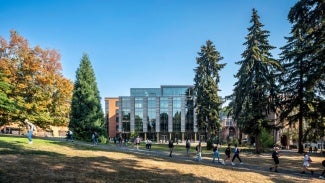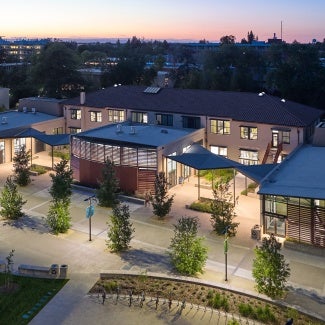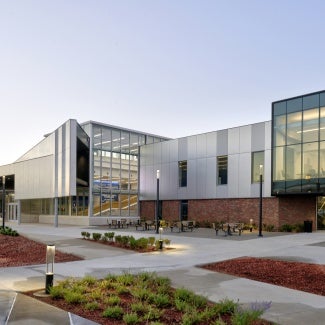Founders Hall, Foster School of Business
The award-winning education facility design of Founders Hall at the University of Washington sets a new standard for embodied and operational carbon reduction as the first mass timber structure on the Seattle campus.

Project highlights: Founders Hall, Foster School of Business
- Architecture firm: LMN Architects
- Owner: University of Washington, Foster School of Business
- Location: Seattle
- Category: Merit
- Project site: Brownfield
- Building program type(s): Education - college/university (campus-level)
Founders Hall is a defining new addition to the University of Washington’s Foster School of Business, setting a new standard on campus for embodied and operational carbon reduction. It’s the first mass timber structure on the Seattle campus, where collaborative learning and community building thrive inside a sustainable building poised to inspire future generations of students.
The team seamlessly integrated Founders Hall into the landscape, strengthening connections to Denny Yard, the university’s historic heart. It accommodates the business school’s rapidly expanding undergraduate program with social spaces that bolster the students’ academic experiences and prompt important networking opportunities with alumni and other industry leaders. As a new social hub, the building is a bustling testament to the university’s commitment to address climate change and social justice.
Joining two additional buildings that serve the business school, Founders Hall creates a vital intersection of three discrete volumes that host collaboration spaces, program offices, classrooms, and gathering spaces linked by a five-story steel and wood stair that weaves through the mass timber structure. Its organization, which places administrative offices next to student spaces on every level, encourages spontaneous interactions among administrators, staff, students, and visitors.
In addition to being the first mass timber structure on campus, Founders Hall is also the first to embrace the university’s elevated green building standards—it reduces carbon emissions by more than 90% and embodied carbon by nearly 60%. Through its design, the building capitalizes on the region’s temperate climate to integrate natural and mechanical ventilation to provide a comfortable environment for occupants with minimal need for conditioned air. The use of cross-laminated timber decking reflects the university’s deep connection to the Northwest’s enduring wood products industry.
Throughout the process, the team ensured that numerous existing Douglas fir and sequoia trees on the site were not only preserved but were a part of the building’s architectural expression. Its facade is paired with sensitively placed glazing to reveal the timber inside and provide views of the surrounding trees. On higher floors, students, faculty, and staff are immersed in the site’s forest character.
In connecting to the history of the university and the forest industry, the building provides meaningful insight into Washington’s culture and heritage, shaping a holistic experience for the campus community. Founders Hall is not merely a place for learning, but a larger symbol of the school’s aspirations to leave a lasting, positive impact on students and the world.
Framework for Design Excellence measures
Was there a design charrette? Yes
Level of community engagement:
Empower: Stakeholders were provided with opportunities to make decisions for the project.
Site area that supported vegetation (landscape or green roof) pre-development: 42%
Site area that supports vegetation post-development: 42%
Site area covered by native plants supporting native or migratory species and pollinators: 100%
Strategies used to promote Design for Ecosystems: Biodiversity, Dark skies, Habitat conservation, Flora/fauna
Is potable water used for irrigation? Yes
Is potable water used for cooling? No
Is grey/blackwater reused on-site? No
Is rainwater collected on-site? No
Stormwater managed on-site: 100%
2030 Commitment baseline EUI: 129 kBtu/sf/yr
Predicted net EUI including on-site renewables: 25 kBtu/sf/yr
Reduction from the benchmark: 81%
Is the project all-electric? Yes
Level of air filters installed: MERV 12-14
Was a “chemicals of concern” list used to inform material selection? Yes
Do greater than 90% of occupied spaces have a direct view to the outdoors? Yes
Were embodied carbon emissions estimated for this project? Yes
Estimated service life: 60 years
Floor area, if any, representing adapting existing buildings: 0%
Ability to survive without utility power: Passive survivability
Risk assessment and resilience services provided: Climate change risk
Has a post-occupancy evaluation been conducted? No, but a POE will be conducted.
Building performance transparency steps taken:
Present the design, outcomes, and/or lessons learned to the office.
Present the design, outcomes, and/or lessons learned to the profession.
Present the design, outcomes, and/or lessons learned to the public.
Project team & Jury
Year of substantial project completion: 2022
Gross conditioned floor area: 84,800 sq. ft.
Architect: LMN Architects
Design-Builder: Hoffman Construction Company
Structural Engineer: Magnusson Klemencic Associates with Katerra, Carla Keel, and Autoscan
Civil Engineer: Mayfly Engineering & Design, Pllc.
Landscape Architect: Gustafson Guthrie Nichol, Ltd.
Lighting Design: HLB Lighting Design
Mechanical and Electrical Engineer: PAE Consulting Engineers, Inc.
Plumbing Engineer: Burman Design
Signage: Studio Matthews
Accessibility: Studio Pacifica
Commissioning: Wilson Jones Commissioning
Envelope Consultant: Morrison Hershfield with McClintock Façade Consulting
LEED Administration and Energy Modeler: O’Brien360
Environmental Graphic Designer: Advent, LLC.
Acoustics: The Greenbusch Group
Design-Build Trade Partners: Pellco Construction (Earthwork & Utilities), Steelkorr (Steel), Performance Contracting, Inc. (Interiors), McKinstry (Mechanical), VECA (Electrical), Herzog Glass (Glazing), OpenSquare (Furniture), Schindler (Elevators)
Lori Cappucio, AIA (Chair), SmithGroup, Washington, DC
Omar Bailey, AIA, Shepley Finch, Phoenix
Vince Gonzales, AIA, Seattle Public Schools, Seattle
Kandis Larsen, AIA, Integrus + YGH, Spokane, Wash.
Sindu Meier, AIA, William Rawn Associates, Milton, Mass.
The Education Facility Design Award recognizes state-of-the-art education environments being developed in today's learning spaces.
Thirteen projects showcase the best in today's learning spaces.





